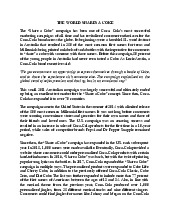

Preview text:
lOMoARcPSD|364 906 32
Identifying Consumer Problems Using Online and Social Media
Traditional methods of discovering consumer problems have tended toward direct questioning of
consumers. Today’s online environment, however, can be seen as a potential goldmine for
identifying consumer problems at both the category and brand levels by monitoring the
“conversations” happening online. Sometimes those conversations will be happening on a
brand’s own online and social media outlets, as when a consumer tweets a company about a
recent product failure. Sometimes these conversations will be happening in the broader social
media environment, as when bloggers discuss product failures or general needs in a specific
product area. Consider the following statements from Radian6, a leader in the field of social media measurement:
Problems, needs, and wish lists from your potential customers or your competitor’s customers
are being tossed out to the social web all the time. From product reviews to casual statements
about what’s not working right, consumers are giving you loads of intelligence about what
problems they need you to solve.
Tracking is not enough—responding to problems and concerns is a critical part of the whole
package. That is, it is not enough to know, via postings on your brand’s Facebook Fan Page, that
there are problems with your newest software release. It is critical that those problems be solved
in a timely and appropriate manner. Radian6’s comments are informative here as well:
[It’s] about understanding how your business solves problems for people, and then connecting
with them in a meaningful, helpful way when they need you most. It’s not about a sales pitch.
It’s about creating a solution for someone that they’re asking for.
Sounds simple, right? Think again. Online and social media outlets (both the company’s and
general) are extensive. Imagine trying to monitor all of the conversations or “chatter” happening
in cyberspace at any given time and filtering that down to usable information. One study by
Forrester Research notes numerous such venues including customer forums, blogs, Facebook,
and Twitter. And that’s before you consider the company’s website and e-mail. These options are
a growing source of potential consumer feedback and input. The challenge is how to track,
consolidate, interpret, and react to all of the online chatter. The interpretation part can be difficult
particularly for non-brand-specific problems. It’s easy to know when a customer is complaining
that your software has a specific flaw; it’s much harder to recognize those broader consumer
needs that lead to truly breakthrough innovations. Though tracking specific types of key words
can help, the interpretation process is still difficult and as yet not well understood. Platforms
such as Radian6—part of Salesforce marketing cloud (salesforce.com)—offer proprietary
solutions to help companies through these and the many challenges associated with this form of consumer problem discovery. Critical Thinking Questions
1. What are some advantages of online and social media tracking compared to traditional methods?
2. In what ways might the viral nature of a given topic be important to marketers in assessing the
importance of a given problem?
3. Do you see any ethical concerns related to this approach? Explain.
Document Outline
- Identifying Consumer Problems Using Online and Social Media




